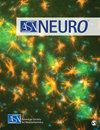侧脑室灌注神经节苷增加小鼠脑内成体神经干细胞库
IF 3.9
4区 医学
Q2 NEUROSCIENCES
引用次数: 5
摘要
我们之前报道过神经节苷脂GD3是神经干细胞(NSCs)中的主要物种,并且在GD3合成酶敲除(GD3S-KO)小鼠大脑的室下区和齿状回(DG)中观察到出生后NSC池减少。具体而言,GD3S-KO动物中GD3的缺乏表明,发育中的小鼠大脑海马DG中的细胞数量显著减少,导致这些动物出现严重的行为缺陷。为了进一步评估GD3在出生后大脑中的功能作用,我们在成年GD3S-KO动物的侧脑室内输注神经节苷脂GD3进行了挽救实验,发现它可以恢复NSC池,增强NSC的自我更新能力。此外,使用5xFAD小鼠模型,GD3恢复NSC数量,GM1促进神经元分化。因此,我们的研究结果表明,外源性给予神经节苷脂能够恢复出生后NSCs的功能。由于神经节苷脂的表达谱不仅与正常大脑发育有关,而且与阿尔茨海默病等疾病的致病机制有关,我们预计,外源性神经节苷脂(如GD3和GM1)的给药可能代表一种新的有效策略,可促进受损大脑中成体神经发生,用于疾病治疗。本文章由计算机程序翻译,如有差异,请以英文原文为准。
Intracerebroventricular Infusion of Gangliosides Augments the Adult Neural Stem Cell Pool in Mouse Brain
We previously reported that ganglioside GD3 is the predominant species in neural stem cells (NSCs) and reduced postnatal NSC pools are observed in both the subventricular zone and dentate gyrus (DG) of GD3-synthase knockout (GD3S-KO) mouse brains. Specifically, deficiency of GD3 in GD3S-KO animals revealed a dramatic reduction in cellularity in the DG of the hippocampus of the developing mouse brain, resulting in severe behavioral deficits in these animals. To further evaluate the functional role of GD3 in postnatal brain, we performed rescue experiments by intracerebroventricular infusion of ganglioside GD3 in adult GD3S-KO animals and found that it could restore the NSC pools and enhance the NSCs for self-renewal. Furthermore, 5xFAD mouse model was utilized, and GD3 restored NSC numbers and GM1 promoted neuronal differentiation. Our results thus demonstrate that exogenously administered gangliosides are capable to restore the function of postnatal NSCs. Since ganglioside expression profiles are associated not only with normal brain development but also with pathogenic mechanisms of diseases, such as Alzheimer’s disease, we anticipate that the administration of exogenous gangliosides, such as GD3 and GM1, may represent a novel and effective strategy for promoting adult neurogenesis in damaged brain for disease treatment.
求助全文
通过发布文献求助,成功后即可免费获取论文全文。
去求助
来源期刊

ASN NEURO
NEUROSCIENCES-
CiteScore
7.70
自引率
4.30%
发文量
35
审稿时长
>12 weeks
期刊介绍:
ASN NEURO is an open access, peer-reviewed journal uniquely positioned to provide investigators with the most recent advances across the breadth of the cellular and molecular neurosciences. The official journal of the American Society for Neurochemistry, ASN NEURO is dedicated to the promotion, support, and facilitation of communication among cellular and molecular neuroscientists of all specializations.
 求助内容:
求助内容: 应助结果提醒方式:
应助结果提醒方式:


